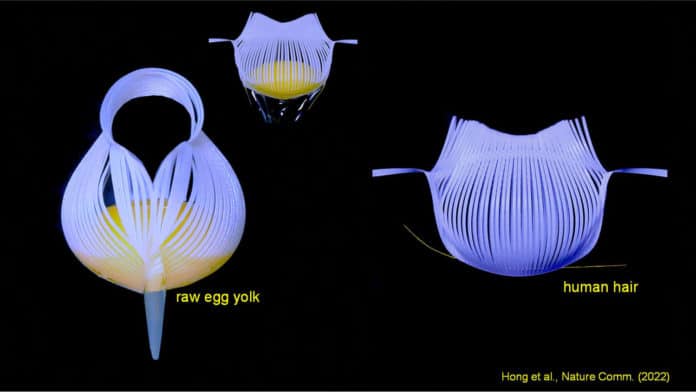Engineering researchers from North Carolina State University have developed a new type of flexible, robotic grippers inspired by the art of kirigami that are able to lift delicate egg yolks without breaking them and that are precise enough to lift a human hair.
Kirigami is a Japanese art similar to Origami that involves both cutting and folding two-dimensional (2D) sheets of material to form three-dimensional (3D) shapes.
The new grippers are made from polyethylene terephthalate (PET) sheet, which is known for its wide uses in the food packaging industry. Researchers have developed a new technique that uses kirigami to convert 2D sheets into curved 3D structures by cutting parallel slits across much of the material. Parallel slits in the sheets were cut out using a laser cutter before being stretched to form their 3D shape. The final shape of the 3D structure is determined in large part by the outer boundary of the material.
The final design involves pulling on two handles to tighten the delicate, claw-like gripping mechanism and pick up soft objects. The grippers gently grasp the very underside of the object and interlock like a cage to create a safe compartment to hold the object.
Researchers say their technique is quite a bit simpler than previous techniques for converting 2D materials into curved 3D structures, and it allows designers to create a wide variety of customized structures from 2D materials. The technique can be used to create tools capable of grasping and moving even extremely fragile objects. The team demonstrated the utility of their technique by creating grippers capable of grabbing and lifting objects ranging from egg yolks to human hair.
“Conventional grippers grasp an object firmly – they grab things by putting pressure on them,” says Jie Yin, corresponding author of the paper. “That can pose problems when attempting to grip fragile objects, such as egg yolks. But our grippers essentially surround an object and then lift it – similar to the way we cup our hands around an object. This allows us to ‘grip’ and moves even delicate objects, without sacrificing precision.”
The team believes that there are a host of other potential applications, such as using the technique to design biomedical technologies that conform to the shape of a joint – like the human knee.
“This is proof-of-concept work that shows our technique works,” Yin says. “We’re now in the process of integrating this technique into soft robotics technologies to address industrial challenges. We are also exploring how this technique could be used to create devices that could be used to apply warmth to the human knee, which would have therapeutic applications.”
“We’re open to working with industry partners to explore additional applications and to find ways to move this approach from the lab into practical use.”
